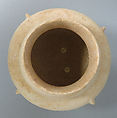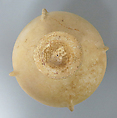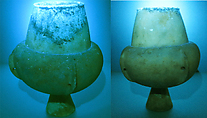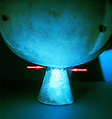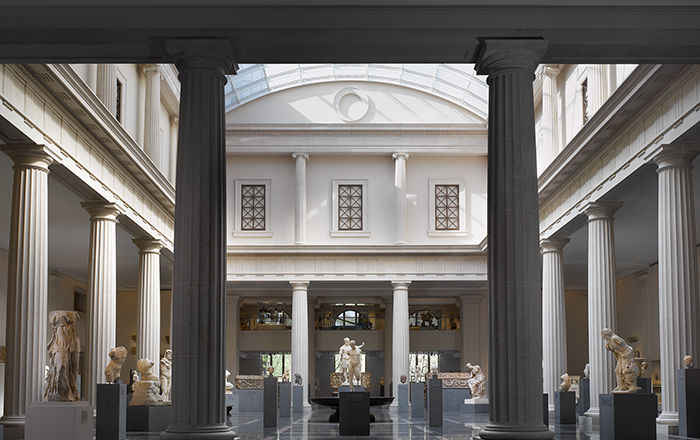On loan to The Met The Met accepts temporary loans of art both for short-term exhibitions and for long-term display in its galleries.
Marble vase with high foot and lug handles
Technical analysis: Ultraviolet-induced visible luminescence examination
This large vessel, carved from white marble, appears complete, but the entire top of the rim and a large section of the neck are lost and have been restored with a painted fill. Fill material, visible under UV light, also encircles the top of the tall foot, suggesting that it may be a separate piece that was attached to the body of the vase. The base also has a small modern drill hole in the bottom. Two of the lug handles have also suffered damage—one in the upper half and the other in the lower half. While the surface of the upper half of the vase is relatively clean, a calcitic encrustation partially covers much of the lower half and approximately one third of the foot.
The vessel, also known as a kandila, after its resemblance to modern oil lamps of similar shape in Greek Orthodox churches, has a slender conical foot, broad rounded body, four pierced crescent-shaped lug handles, and a tapering slightly convex neck with a contoured rim. Attributed to the so-called Kandila Sculptor A, the pedestal and lugs are finely carved, but notably the lugs are neither equally spaced nor perfectly vertical. Produced in marble and clay, kandilai typically held liquids, such as oil or wine. Cords strung through the pierced lugs around the body could be used to hang the vase or attach a lid. Frequently found in tombs with marble figures, the vessels may have served a function in funerary rituals.
Alexis Belis and J-F de Lapérouse
This image cannot be enlarged, viewed at full screen, or downloaded.
This artwork is meant to be viewed from right to left. Scroll left to view more.





